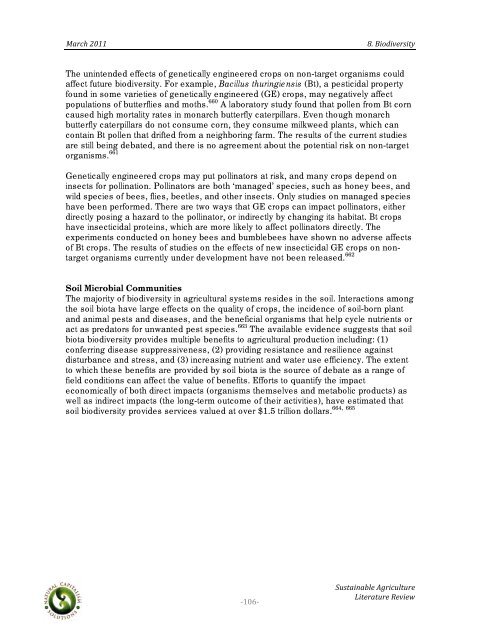Sustainable Agriculture Literature Review - Boulder County
Sustainable Agriculture Literature Review - Boulder County
Sustainable Agriculture Literature Review - Boulder County
You also want an ePaper? Increase the reach of your titles
YUMPU automatically turns print PDFs into web optimized ePapers that Google loves.
! !!<br />
"#$%&!'())!! !!!!!!!!!!!!!!!!!!!!!!!!!!!!!!!!!!!!!!!!!!!!!!!!!!!!!!!!!!!!!!!!!!!!!!!C+!D.-E.;1$4.2F!<br />
The unintended effects of genetically engineered crops on non-target organisms could<br />
affect future biodiversity. For example, Bacillus thuringiensis (Bt), a pesticidal property<br />
found in some varieties of genetically engineered (GE) crops, may negatively affect<br />
populations of butterflies and moths. 660 A laboratory study found that pollen from Bt corn<br />
caused high mortality rates in monarch butterfly caterpillars. Even though monarch<br />
butterfly caterpillars do not consume corn, they consume milkweed plants, which can<br />
contain Bt pollen that drifted from a neighboring farm. The results of the current studies<br />
are still being debated, and there is no agreement about the potential risk on non-target<br />
organisms. 661<br />
Genetically engineered crops may put pollinators at risk, and many crops depend on<br />
insects for pollination. Pollinators are both ‘managed’ species, such as honey bees, and<br />
wild species of bees, flies, beetles, and other insects. Only studies on managed species<br />
have been performed. There are two ways that GE crops can impact pollinators, either<br />
directly posing a hazard to the pollinator, or indirectly by changing its habitat. Bt crops<br />
have insecticidal proteins, which are more likely to affect pollinators directly. The<br />
experiments conducted on honey bees and bumblebees have shown no adverse affects<br />
of Bt crops. The results of studies on the effects of new insecticidal GE crops on nontarget<br />
organisms currently under development have not been released. 662<br />
Soil Microbial Communities<br />
The majority of biodiversity in agricultural systems resides in the soil. Interactions among<br />
the soil biota have large effects on the quality of crops, the incidence of soil-born plant<br />
and animal pests and diseases, and the beneficial organisms that help cycle nutrients or<br />
act as predators for unwanted pest species. 663 The available evidence suggests that soil<br />
biota biodiversity provides multiple benefits to agricultural production including: (1)<br />
conferring disease suppressiveness, (2) providing resistance and resilience against<br />
disturbance and stress, and (3) increasing nutrient and water use efficiency. The extent<br />
to which these benefits are provided by soil biota is the source of debate as a range of<br />
field conditions can affect the value of benefits. Efforts to quantify the impact<br />
economically of both direct impacts (organisms themselves and metabolic products) as<br />
well as indirect impacts (the long-term outcome of their activities), have estimated that<br />
664, 665<br />
soil biodiversity provides services valued at over $1.5 trillion dollars.<br />
!<br />
"'&%"<br />
!,342#.5#6/1!78$.%3/23$1!<br />
9.21$#23$1!:1;.1
















